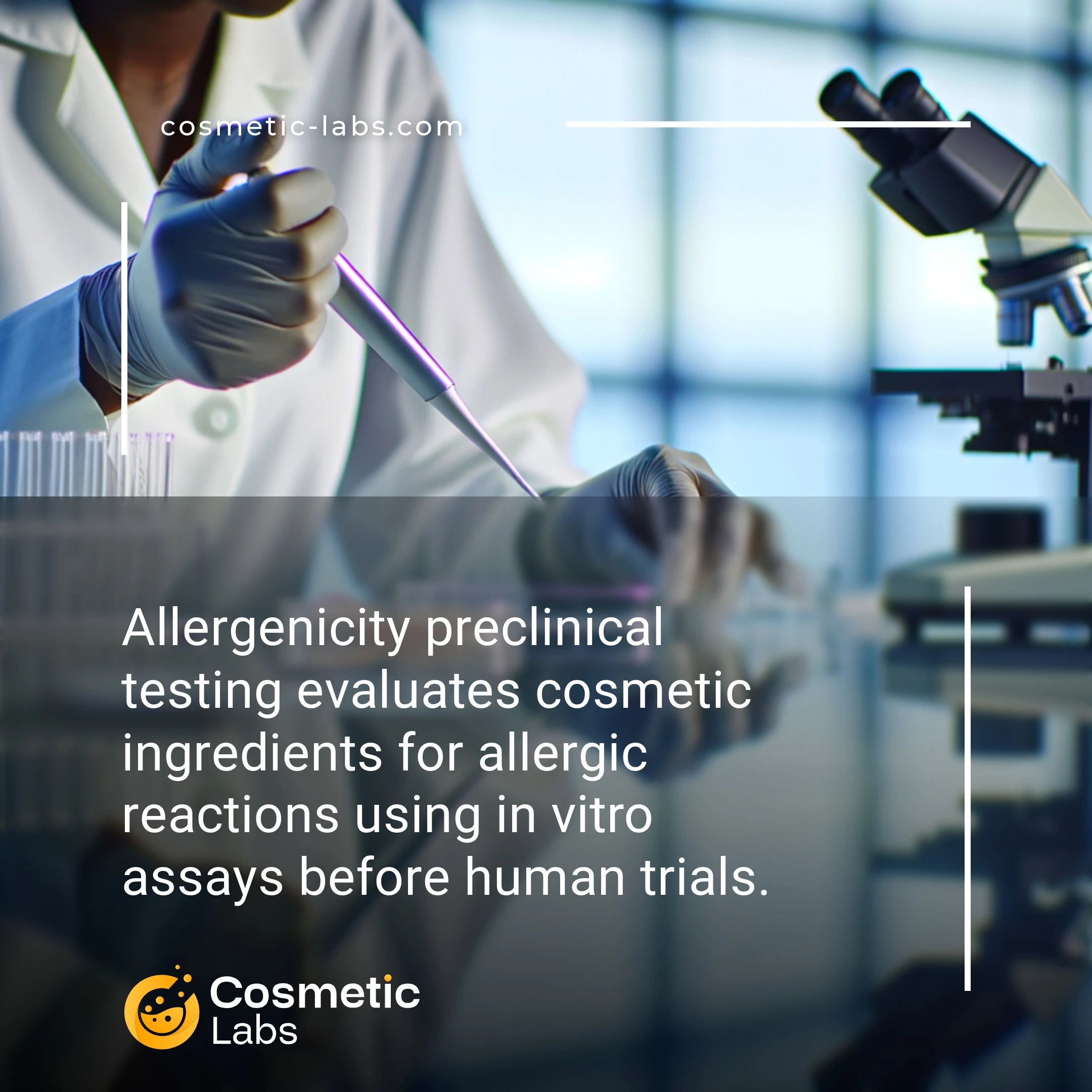Allergenicity Testing Services for Safe Cosmetic Products

What is Allergenicity preclinical testing?
Allergenicity preclinical testing services evaluate cosmetic ingredients and formulations for potential allergic reactions before human trials begin. Labs use in vitro assays like the DPRA and KeratinoSens tests to predict skin sensitization risk, helping brands identify problematic compounds early in development. This testing replaces traditional animal models while providing reliable data for regulatory submissions and consumer safety documentation.
Why do you need this service?
Beauty brands rely on patch testing protocols to screen new formulations before consumer trials, identifying potential sensitizers in fragrance blends, preservative systems, and botanical extracts. Labs conduct LLNA assays and human repeat insult patch tests to generate safety data for regulatory submissions, helping you avoid costly recalls and build consumer confidence in sensitive skin claims.
Who provides Allergenicity preclinical testing services?
All cosmetic labs providing Allergenicity preclinical testing services
There is no company providing these services at the moment.
Allergenicity Preclinical Testing Services
Allergenicity testing forms a critical component of preclinical efficacy testing, helping brands identify potential skin sensitization risks before product launch. Labs use validated protocols to assess how ingredients and formulations interact with skin cells, providing data that supports safety claims and regulatory submissions.
In Vitro Sensitization Testing Methods
Modern labs employ cell-based assays that replace traditional animal testing while delivering reliable results. The Direct Peptide Reactivity Assay (DPRA) measures how test substances bind to skin proteins, while the KeratinoSens™ assay evaluates cellular stress responses in human keratinocytes.
These methods typically include:
- DPRA testing for direct chemical reactivity
- KeratinoSens™ for oxidative stress pathway activation
- h-CLAT assays measuring dendritic cell activation
- Integrated testing strategies combining multiple endpoints
Results help formulators adjust ingredient concentrations and select safer alternatives during product development.
Patch Testing and Skin Compatibility Assessment
Labs conduct controlled patch testing studies to evaluate real-world sensitization potential under clinical conditions. These studies apply test products to volunteer skin patches for 24-48 hours, monitoring for inflammatory responses and delayed hypersensitivity reactions.
Standard protocols include:
- Preliminary screening with dilution series
- Repeat insult patch testing (RIPT) over 6 weeks
- Challenge phase testing after rest periods
- Dermatological evaluation and scoring
This data supports hypoallergenic claims and helps brands understand safe usage levels for consumer products. Connect with experienced labs on our platform to discuss your specific allergenicity testing requirements.
5 subcategories of Allergenicity preclinical testing services
There are no results matching your search
Practical Applications of Allergenicity Preclinical Testing Services
Beauty brands rely on allergenicity preclinical testing applications to identify potential skin reactions before product launch, protecting both consumers and brand reputation.
Cosmetic Formulation Safety Assessment
Labs conduct patch testing and sensitization studies on new ingredient combinations to predict allergic reactions. In vitro testing methods like the Direct Peptide Reactivity Assay (DPRA) screen for skin sensitizers within 48 hours. Teams also run human repeat insult patch tests (HRIPT) with 200+ volunteers over 6 weeks to establish safety thresholds.
Fragrance allergen testing identifies problematic compounds in essential oils and synthetic fragrances. Labs test individual components against the EU’s 26 regulated allergens, providing concentration limits for compliant formulations.
Regulatory Compliance and Market Entry
Brands submit allergenicity data to meet FDA, EU, and international safety requirements. Predictive testing models like QSAR analysis evaluate molecular structures for allergenic potential without animal testing. Labs generate comprehensive safety dossiers including dose-response curves and no-observed-adverse-effect levels (NOAEL).
Pre-market testing prevents costly recalls and regulatory delays. Products with documented allergenicity profiles gain faster approval in multiple markets, reducing time-to-market by 3-6 months.
| Testing Method | Timeline | Application | Regulatory Acceptance |
|---|---|---|---|
| DPRA (Direct Peptide Reactivity) | 48 hours | Ingredient screening | OECD 442C |
| KeratinoSens™ | 3-5 days | Sensitization pathway | OECD 442D |
| Human Patch Testing | 6-8 weeks | Final product validation | FDA/EU accepted |
| QSAR Modeling | 24-48 hours | Early screening | Supporting data |
Connect with experienced cosmetic labs on our platform to design allergenicity testing protocols that match your product development timeline and regulatory requirements.

